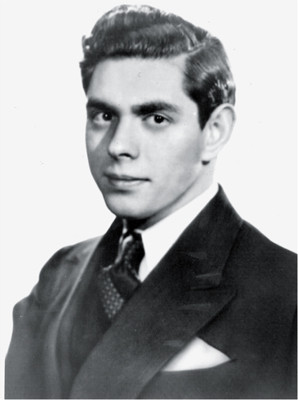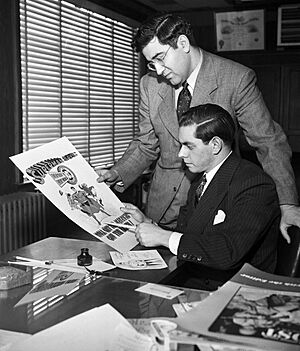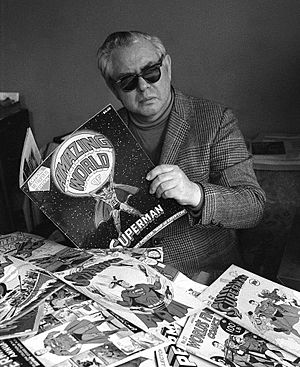Joe Shuster facts for kids
Quick facts for kids Joe Shuster |
|
|---|---|

Shuster in 1939
|
|
| Born | Joseph Shuster July 10, 1914 Toronto, Ontario, Canada |
| Died | July 30, 1992 (aged 78) Los Angeles, California, U.S. |
| Nationality | Canadian, American |
| Area(s) | Penciller, Artist |
|
Notable works
|
Superman, Action Comics #1 |
| Awards | Inkpot Award, 1975 Will Eisner Award Hall of Fame, 1992 Jack Kirby Hall of Fame, 1993 Joe Shuster Canadian Comic Book Creator Hall of Fame, 2005 |
| Signature | |
 |
|
Joseph Shuster (pronounced SHOO-stər; July 10, 1914 – July 30, 1992), known as Joe Shuster, was a talented Canadian-American comic book artist. He is famous for helping create the superhero Superman. He worked with his friend Jerry Siegel to bring Superman to life in Action Comics #1 in June 1938.
Shuster faced several legal challenges about who owned the Superman character. After Superman became famous, his other comic book work was not as successful. By the mid-1970s, Shuster stopped working in comics because he was losing his eyesight.
Both he and Siegel were honored in the comic book world. They were inducted into the Will Eisner Comic Book Hall of Fame in 1992. They also joined the Jack Kirby Hall of Fame in 1993. In 2005, a special award called the Joe Shuster Awards was created to honor Canadian comic book artists like him.
Contents
Joe Shuster's Early Life and Work
Joseph Shuster was born in Toronto, Canada, into a Jewish family. His father, Julius Shuster, was a tailor who came from Rotterdam. His mother, Ida, was from Kyiv, which is now in Ukraine. Joe lived with his family, including his sister Jean, in Toronto. He went to Ryerson and Lansdowne Public Schools there. A famous comedian named Frank Shuster was one of his cousins.
When Joe was young, he worked as a newspaper boy for the Toronto Daily Star. His family didn't have much money, so Joe often looked for paper to draw on. He remembered finding unused wallpaper rolls. The blank backs were perfect for drawing, and he used them for a long time.
Around 1924, when Joe was about 9 or 10, his family moved to Cleveland, Ohio. There, he went to Glenville High School. This is where he met Jerry Siegel, who would become his writing partner. They started a science fiction fanzine (a fan magazine) together called Science Fiction. Jerry Siegel said that when he and Joe met, it was like "the right chemicals coming together." They were both shy and wore glasses.
The two friends started working in comics for Major Malcolm Wheeler-Nicholson's company, National Allied Publications. This company later became DC Comics. They worked on New Fun, which was the first comic book series to have only new stories. Their first strips were "Henri Duval" and "Doctor Occult" in New Fun #6 (October 1935). Joe said that the first drawings they sent to the publisher were on brown wrapping paper and wallpaper. The company liked their ideas but asked them to redraw the stories on better paper.
How Superman Was Created
Siegel and Shuster first created a different character called "The Superman." This character was a bald, mind-reading villain who wanted to rule the world. This story was published in Siegel's 1933 fanzine Science Fiction #3. But this villain character was not popular, so they didn't use him again.
Later, Siegel decided to use the name The Superman for a new hero. This new hero became one of the most famous superheroes ever! Shuster based the hero's look on actor Douglas Fairbanks Sr.. He modeled Superman's secret identity, Clark Kent, on a mix of actor Harold Lloyd and himself. The name "Clark Kent" came from movie stars Clark Gable and Kent Taylor. Lois Lane was based on Joanne Carter, a model Shuster hired. She later married Jerry Siegel.
Many people believe that Siegel and Shuster's backgrounds as children of Jewish immigrants influenced their work. They created a hero who was like an immigrant. This hero wanted to fit into American culture, which is an important part of the American story.
Siegel and Shuster spent six years trying to find a publisher for their new hero. They called the character The Superman. They offered it to Consolidated Book Publishing, but that company stopped publishing comic books. Shuster was very upset by this rejection. He either burned all the pages of the story, or tore them up. Only the cover survived because Siegel saved it.
In 1938, their idea was still waiting at More Fun Comics, which was part of National Allied Publications. The editor, Vin Sullivan, chose Superman to be the main story for National's Action Comics #1 (June 1938). The next year, Siegel and Shuster also started a Superman comic strip that appeared in newspapers.

When Superman first appeared, his secret identity, Clark Kent, worked for the Daily Star newspaper. Shuster named it after the Toronto Daily Star, where he used to be a newspaper boy. When the comic strip became popular around the world, the company changed the newspaper's name to the Daily Planet. Shuster said he based the look of Superman's home city, Metropolis, on his old hometown of Toronto.
As part of the deal to publish Superman in Action Comics, Siegel and Shuster sold the rights to the character. They received $130 and a contract to provide more stories and art.
The company that published Action Comics #1 eventually became DC Comics.
Later Career and Recognition
In 1947, Siegel and Shuster worked with editor Sullivan again. They created a funny crime-fighter called Funnyman, but it didn't last long. Shuster continued to draw comics after Funnyman, but it's not clear exactly what he drew. Some historians say he drew horror stories in the 1950s.
In 1964, Shuster was living on Long Island with his mother. He was working as a freelance cartoonist and trying to create pop art. At one point, his eyesight got worse, and he couldn't draw anymore. He worked as a deliveryman to make a living.
In 1967, when the Superman copyright was up for renewal, Siegel started another lawsuit. This one was also not successful.
In 1975, Siegel began a public campaign to protest how DC Comics had treated him and Shuster. Many people, including other comic artists, supported them. By 1976, Shuster was almost blind and living in a nursing home. Because of the negative attention and the upcoming Superman movie, DC's parent company, Warner Communications, made a change. They started giving Siegel and Shuster credit in the comics again. They also gave them a lifetime pension and health benefits. The first comic with their names restored was Superman #302 (August 1976).
Even with the pension, Shuster had some debts when he died. After his death, DC Comics agreed to pay off his debts. In return, his family agreed not to challenge the ownership of Superman.
Death
Joe Shuster passed away on July 30, 1992, at his home in West Los Angeles. He was 78 years old.
Awards and Honors
- In 1985, DC Comics honored Shuster in their 50th anniversary book, Fifty Who Made DC Great.
- In 1992, Shuster was inducted into the Will Eisner Award Hall of Fame.
- In 2005, Shuster was inducted into the Joe Shuster Canadian Comic Book Creator Hall of Fame.
- The Joe Shuster Awards, started in 2005, are named after him. They celebrate achievements by Canadian comic book creators, publishers, and retailers.
- In Toronto, where Shuster was born, a street called Joe Shuster Way is named in his honor.
- In Cleveland, Ohio, there is a mural that includes a tribute to Siegel and Shuster.
- Amor Avenue in Cleveland's Glenville neighborhood was renamed "Joe Shuster Lane."
See also
 In Spanish: Joe Shuster para niños
In Spanish: Joe Shuster para niños


